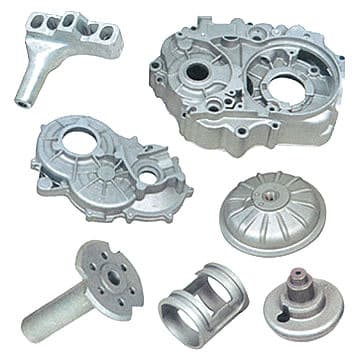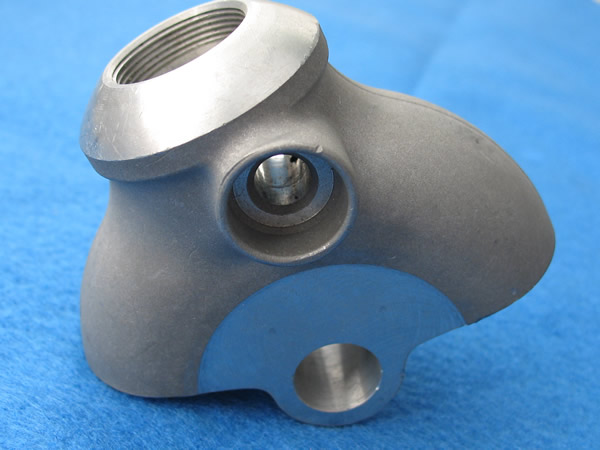Aluminum Castings and green manufacturing: Why they matter
Exploring the Perks and Techniques of Aluminum Casting in Modern Production
Aluminum casting has actually emerged as a crucial strategy in modern-day production. Its lightweight residential properties improve energy performance and minimize transport expenses. Additionally, innovations in casting techniques make it possible for detailed styles and rapid prototyping. Nonetheless, the advantages expand beyond plain effectiveness. The sustainability of aluminum casting procedures presents significant effects for different industries. Understanding these facets can reveal the transformative impact of aluminum in contemporary manufacturing practices. What more developments could redefine its duty?
The Lightweight Advantage of Aluminum Casting
Aluminum casting uses a significant light-weight advantage that is changing sectors reliant on sturdy yet workable materials. This property is especially beneficial in fields such as automobile and aerospace, where every ounce counts in efficiency and gas efficiency. The minimized weight of aluminum components permits boosted handling, lower transportation costs, and improved power performance during procedure. Unlike much heavier metals, aluminum supplies a balance of toughness and agility, making it a suitable option for complicated applications that demand high performance without compromising architectural stability. Additionally, the rust resistance of aluminum expands the life-span of actors components, minimizing the demand for frequent replacements. This combination of lightweight attributes and durability positions aluminum casting as an important innovation in modern-day production procedures, urging technology and sustaining the development of innovative products that meet the developing needs of different sectors.
Boosted Style Versatility and Complexity
Style versatility and complexity are noticeably improved with making use of aluminum casting, enabling producers to create intricate forms and types that were previously unattainable with conventional approaches. This capability makes it possible for the manufacturing of elements with comprehensive geometries, such as intricate inner passages and thin-walled structures, which can especially enhance the efficiency of the last product.
Aluminum casting techniques, such as die casting and sand casting, promote fast prototyping, enabling developers to iterate and refine their ideas swiftly. The capacity to create personalized mold and mildews likewise adds to much better placement with certain design needs, decreasing material waste and decreasing the requirement for comprehensive machining.
In addition, the lightweight nature of aluminum enhances its layout flexibility, as it enables for both visual charm and useful effectiveness. On the whole, the improvements in aluminum casting give producers with the devices to push the borders of design, cultivating development throughout different industries.

Superior Thermal and Electric Conductivity
Aluminum's exceptional thermal and electrical conductivity makes it an important product in different production applications. Compared to various other metals, aluminum offers substantial benefits, particularly in warmth dissipation and electrical performance. Aluminum Castings. This property allows its extensive usage in industries varying from automobile to electronic devices, improving total performance and integrity
Thermal Conductivity Advantages
A key advantage of aluminum casting depends on its premium thermal and electrical conductivity, making it an ideal selection for various applications in modern-day manufacturing. The high thermal conductivity of aluminum enables efficient warm dissipation, which is vital in industries such as automobile and electronic devices. Components crafted from aluminum can properly handle temperature level fluctuations, extending the life-span of items and enhancing performance. This feature also enables makers to create lightweight styles without endangering thermal performance. Furthermore, aluminum's ability to endure thermal cycling additionally strengthens its position popular atmospheres. As industries progressively focus on power efficiency and performance, the thermal conductivity advantages of aluminum casting become progressively significant in driving development and sustainability.
Electrical Conductivity Applications
The electrical conductivity of aluminum matches its thermal residential properties, making it a valuable material in various applications within modern manufacturing. This conductivity enables effective energy transfer, which is crucial in electrical elements such as electrical wiring, adapters, and motherboard. Aluminum's light-weight nature additionally improves its charm in applications where lowering weight is essential, such as in aerospace and automotive sectors. In addition, aluminum casting permits the creation of complex forms, maximizing the efficiency of electric gadgets. The material's resistance to corrosion and oxidation additionally adds to durability in electric atmospheres, guaranteeing reliability. Overall, aluminum's exceptional electrical conductivity positions it as a recommended option in industries that demand high performance and performance in their electrical applications.
Comparison With Various Other Metals
While aluminum is renowned for its remarkable thermal and electrical conductivity, it is essential to contrast its residential properties with those of various other steels to understand its benefits completely. Copper, for circumstances, exhibits even greater electric conductivity, making it more suitable in certain applications like circuitry. Nonetheless, copper's weight and expense can limit its use. In comparison, aluminum uses a positive equilibrium of conductivity, weight, and affordability, making it optimal for many manufacturing applications. Furthermore, aluminum's thermal conductivity is usually superior to that of stainless-steel and titanium, which are frequently utilized in high-temperature atmospheres. Ultimately, aluminum stands out not only for its conductivity however likewise for its lightweight and corrosion-resistant homes, making it a versatile choice in contemporary manufacturing.
Cost-Effectiveness and Decreased Material Waste
Making best use of cost-effectiveness and minimizing product waste are important advantages of aluminum casting in modern manufacturing. Aluminum's lightweight nature contributes to decrease shipping costs and energy usage throughout production. Furthermore, its superb recyclability indicates that scrap material produced during the casting procedure can be reused, substantially reducing the total product expenses.
Additionally, aluminum casting techniques usually allow for complex shapes to be generated with fewer additional procedures, which streamlines the manufacturing procedure and reduces labor costs. The capacity to develop precise elements minimizes the demand for extreme machining, additional reducing waste.
Companies embracing aluminum casting benefit from minimized production time and raised effectiveness, resulting in total cost financial savings. This combination of lower product expenses, reliable recycling approaches, and effective production procedures placements aluminum casting as a monetarily advantageous option in the affordable landscape of modern-day production.
Innovations in Aluminum Casting Techniques
Recent developments in aluminum casting methods are transforming the manufacturing landscape. Developments such as the combination of additive manufacturing, boosted mold designs, and environmentally friendly casting procedures are driving effectiveness and sustainability. These developments not only improve item top quality but also lower environmental impact in the aluminum casting sector.
Additive Manufacturing Integration
Additive manufacturing is changing aluminum casting techniques by allowing the production of complicated geometries and light-weight structures that were formerly unattainable. This integration permits suppliers to take advantage of 3D printing technologies to develop complex molds and cores, which promote the casting of thorough styles with enhanced accuracy. Furthermore, additive production reduces material waste and reduces preparations, making it a more lasting and effective approach. Consequently, business can respond a lot more swiftly to market needs and personalize items to satisfy specific customer needs. This harmony between additive manufacturing you can try here and aluminum casting not only enhances layout adaptability however likewise settings makers to innovate constantly, driving innovations in efficiency and item performance within the affordable landscape of modern manufacturing.

Boosted Mold And Mildew Style
As producers seek to boost effectiveness and item high quality, technologies in mold and mildew style have actually emerged as a crucial consider modern aluminum casting strategies. Advanced mold materials, such as silicon carbide and graphite, boost thermal conductivity and resilience, enabling faster cooling and boosted surface area finishes. The combination of computer-aided design (CAD) technology allows specific mold and mildew geometries, helping with complicated shapes that were formerly testing to attain. Advancements like 3D-printed molds also provide rapid prototyping capabilities, decreasing lead times considerably. Additionally, modular mold and mildew layouts allow for less complicated modifications and repairs, decreasing downtime throughout production. Jointly, these improvements not only streamline manufacturing procedures however likewise add to the general quality of aluminum cast products, fulfilling the evolving demands of various markets.
Eco-Friendly Casting Processes
While the aluminum casting market remains to advance, an check out here expanding focus on sustainability has actually brought about the development of eco-friendly casting procedures. These ingenious strategies aim to decrease ecological impact by reducing waste and power consumption. One noteworthy method entails using recycled aluminum, which substantially decreases the carbon impact linked with basic material extraction. Furthermore, improvements in mold materials and styles enable for much more efficient heat transfer, reducing power needs throughout manufacturing. Water-based finishes and binders replace traditional solvents, furthermore lowering dangerous exhausts. Some manufacturers are embracing closed-loop systems, guaranteeing that waste materials are recycled within the manufacturing cycle. Jointly, these environmentally friendly casting refines not only enhance sustainability however also add learn this here now to an extra accountable manufacturing landscape.
Sustainability in Aluminum Casting Processes
Sustainability in aluminum casting procedures has come to be a focal point for producers intending to decrease their ecological effect. The industry is increasingly adopting techniques that reduce waste and boost source performance. One considerable technique includes the usage of recycled aluminum, which calls for just a portion of the power required to generate brand-new steel from ore. This not only preserves sources yet also minimizes greenhouse gas discharges related to manufacturing.
Innovations in technology have actually led to even more energy-efficient casting methods, such as low-pressure and gravity casting, which optimize product usage and decrease power intake. Aluminum Castings. Manufacturers are additionally executing closed-loop systems that permit for the recycling of scrap material produced during the casting process. Furthermore, the usage of green finishes and lubes additionally contributes to a much more sustainable procedure. On the whole, these efforts show a dedication to ecological stewardship while preserving the high quality and efficiency of aluminum casting
Applications of Aluminum Casting Across Industries
Aluminum casting finds considerable applications across various sectors due to its lightweight, stamina, and versatility. In the auto sector, aluminum castings are utilized to generate engine blocks, transmission housings, and wheels, enhancing gas effectiveness while reducing emissions. The aerospace sector utilizes aluminum spreadings for structural parts, gaining from their high strength-to-weight ratio, which is essential for flight security and efficiency.
In the consumer electronics sector, aluminum castings are utilized for housing and structural elements, offering resilience and aesthetic charm. In addition, the construction market leverages aluminum spreadings for architectural aspects and components, taking advantage of their resistance to rust.
In addition, the marine market includes aluminum spreadings in boat frameworks and engine parts, mirroring its suitability for severe atmospheres. Generally, the diverse applications of aluminum casting underscore its importance in modern production, contributing to innovation and effectiveness throughout different areas.
Often Asked Inquiries
What Are the Common Alloys Made Use Of in Aluminum Casting?
The common alloys made use of in aluminum casting consist of 413, 356, and A380. These alloys are valued for their excellent fluidity, strength, and deterioration resistance, making them appropriate for different applications in manufacturing and design.
Just How Does Aluminum Casting Contrast to Various Other Casting Methods?
Aluminum casting offers distinct advantages over other casting approaches, such as lighter weight, excellent corrosion resistance, and exceptional thermal conductivity. It also allows for elaborate designs and faster production times contrasted to typical products like iron or steel.
What Is the Normal Lifespan of Aluminum Cast Products?
The common lifespan of aluminum actors products varies, generally ranging from 20 to half a century, relying on aspects such as environmental conditions, maintenance, and specific applications. Correct treatment can considerably expand their longevity and performance.
Exist Any Wellness Dangers Connected With Aluminum Casting?
The question of wellness risks connected with aluminum casting develops as a result of prospective exposure to aluminum dirt and fumes. Prolonged breathing may lead to respiratory system problems, stressing the significance of appropriate precaution during the casting procedure.
How Can Issues Be Reduced in Aluminum Casting?
To reduce defects in aluminum casting, makers can implement rigid quality assurance procedures, optimize mold and mildew designs, preserve correct temperature control, utilize ideal alloy compositions, and use reliable cleaning methods to guarantee a defect-free casting process.